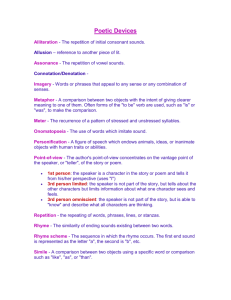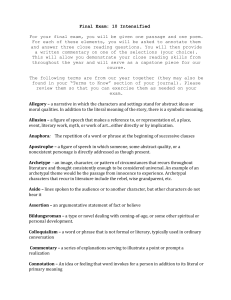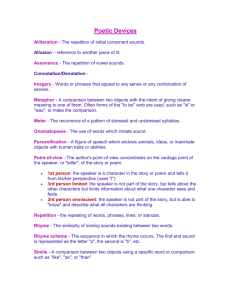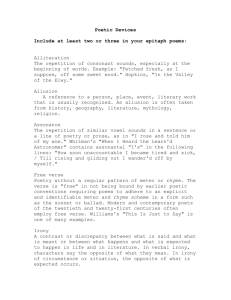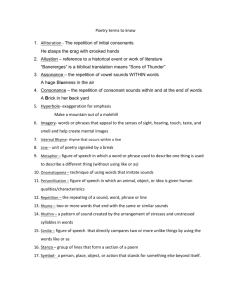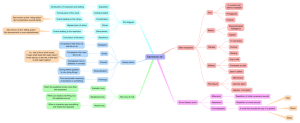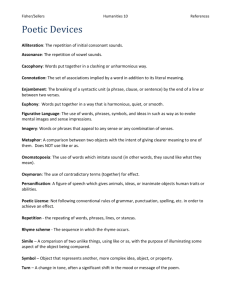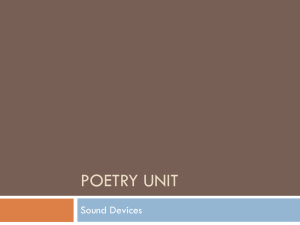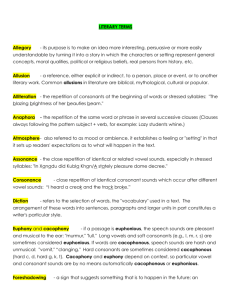Literary Devices: Definitions & Examples
advertisement
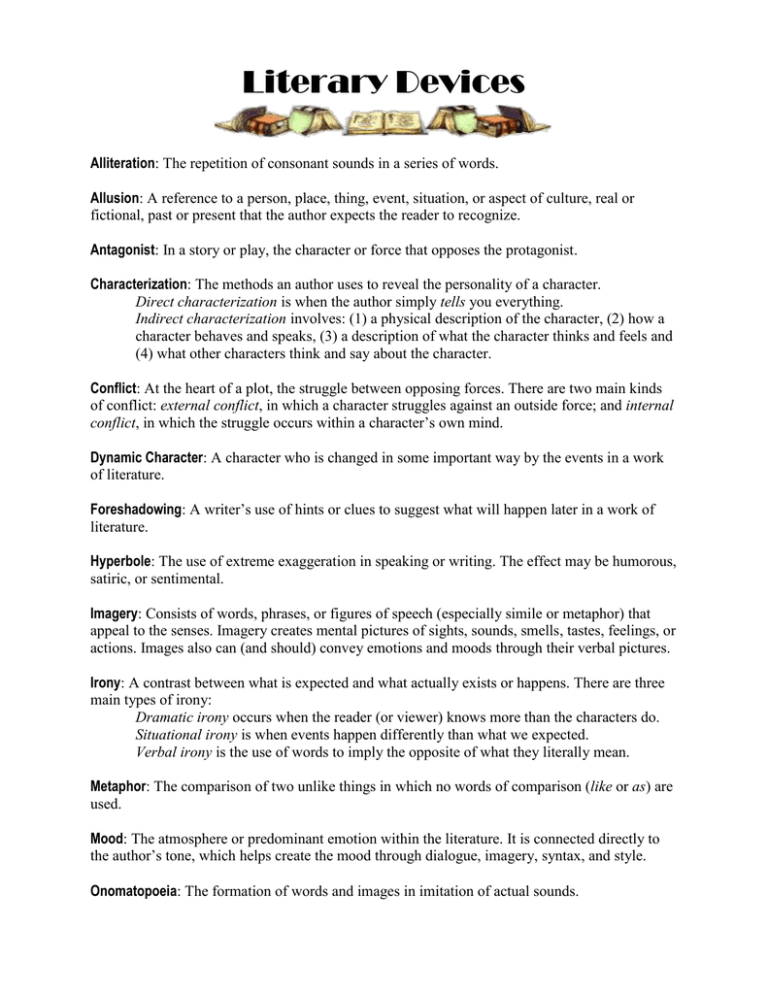
Literary Devices Alliteration: The repetition of consonant sounds in a series of words. Allusion: A reference to a person, place, thing, event, situation, or aspect of culture, real or fictional, past or present that the author expects the reader to recognize. Antagonist: In a story or play, the character or force that opposes the protagonist. Characterization: The methods an author uses to reveal the personality of a character. Direct characterization is when the author simply tells you everything. Indirect characterization involves: (1) a physical description of the character, (2) how a character behaves and speaks, (3) a description of what the character thinks and feels and (4) what other characters think and say about the character. Conflict: At the heart of a plot, the struggle between opposing forces. There are two main kinds of conflict: external conflict, in which a character struggles against an outside force; and internal conflict, in which the struggle occurs within a character’s own mind. Dynamic Character: A character who is changed in some important way by the events in a work of literature. Foreshadowing: A writer’s use of hints or clues to suggest what will happen later in a work of literature. Hyperbole: The use of extreme exaggeration in speaking or writing. The effect may be humorous, satiric, or sentimental. Imagery: Consists of words, phrases, or figures of speech (especially simile or metaphor) that appeal to the senses. Imagery creates mental pictures of sights, sounds, smells, tastes, feelings, or actions. Images also can (and should) convey emotions and moods through their verbal pictures. Irony: A contrast between what is expected and what actually exists or happens. There are three main types of irony: Dramatic irony occurs when the reader (or viewer) knows more than the characters do. Situational irony is when events happen differently than what we expected. Verbal irony is the use of words to imply the opposite of what they literally mean. Metaphor: The comparison of two unlike things in which no words of comparison (like or as) are used. Mood: The atmosphere or predominant emotion within the literature. It is connected directly to the author’s tone, which helps create the mood through dialogue, imagery, syntax, and style. Onomatopoeia: The formation of words and images in imitation of actual sounds. Personification: A figure of speech in which an animal, object, natural force, or idea is given personality or described as if it were human. Point of View: The perspective, or vantage point, from which a story is told. First-person point of view tells everything from the vantage point of a character in the story. We can only know and observe what this character knows and observes. Third-person limited point of view is told by a narrator who is not a character and who stands outside the story’s action, telling the story through the eyes of one character. Omniscient (all-knowing) point of view: The narrator, an outside observer, knows everything about the characters and their problems (past, present, and future). Protagonist: The main character in a story. Repetition: The uses of the same word, phrase, or sound more than once, for emphasis or effect. Rhyme: The repetition of sounds in lines of poetry. There are several types of rhyme. The most common are: Approximate (or slant, or near) rhyme occurs when the sounds of words are similar but not identical. End rhyme is the rhyming of words at the end of lines of poetry. Internal rhyme can be used to achieve emphasis or variety within a line. Rhyme Scheme: The pattern of end rhymes in a poem (ex. abab). Simile: A comparison made between two dissimilar things in which a word of comparison (like or as) is used. Static Character: A character who remains the same throughout the story. Suspense: A feeling of anxiety or excitement that a reader feels about what will happen next. Symbol: Something used to represent something else. In literature the term symbol usually refers to a concrete image used to designate an abstract quality or concept. Theme: The main idea or underlying message of a literary work. A theme may be directly stated but is more often implied. Theme differs from the subject of a literary work in that it usually makes an observation about the subject. Tone: The writer’s attitude toward his or her subject. Plot Elements Plot: The series of interrelated events that make up the total action of a story. Setting: The time and place in which the events of a story occur. Exposition: An introduction to the main characters, settings, and situations of a story. Rising Action: The character encounters conflicts as the plot develops. Climax: The decisive moment in the conflict of a story or play; the moment of highest interest. Falling Action: Conflicts are resolved. The story is brought to a close. Resolution (Denouement): The final outcome.
